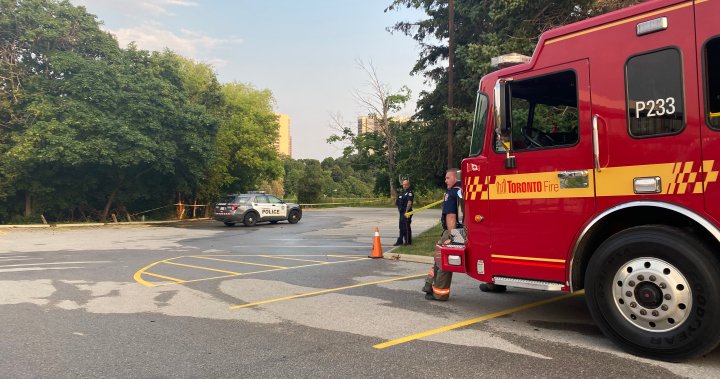In the frigid pre-dawn hours of Wednesday morning, flames tore through a homeless encampment in Toronto’s Don Valley, claiming one life and igniting renewed debate about the city’s approach to managing its growing unhoused population. The fatal fire, which erupted around 5:30 a.m. near Bayview Avenue and Rosedale Valley Road, marks a tragic escalation in what has become a persistent humanitarian challenge for Canada’s largest city.
“One person was located deceased at the scene,” confirmed Toronto Fire Services Acting Chief Jim Jessop during a somber press conference. “Our crews faced significant challenges accessing the site due to its remote location, steep terrain, and the freezing temperatures that hampered water supply efforts.”
The victim’s identity has not been released pending notification of next of kin, but the death has sent shockwaves through Toronto’s homeless advocacy community, which has long warned about the dangers faced by those living in outdoor encampments, particularly during winter months.
This tragedy occurs against the backdrop of increasing encampment fires across Toronto. Fire services report responding to 164 encampment fires already in 2024—a 25% increase from the same period last year. These blazes often result from makeshift heating methods used by residents desperate to survive frigid Canadian winters.
“People resort to whatever means necessary to stay warm when they have nowhere else to go,” explained Diana Chan McNally, a housing advocate with the Toronto Drop-In Network. “Candles, propane heaters, small fires—all carry inherent risks in temporary shelters made of flammable materials like tarps and tents.”
The city’s controversial encampment eviction policies have come under renewed scrutiny following the incident. Mayor Olivia Chow, who has adopted a more measured approach than her predecessor, acknowledged the complexity of the situation during an emergency meeting with city officials.
“This is a heartbreaking reminder of the dangers faced by our unhoused neighbors,” Mayor Chow stated. “While we must address legitimate public safety concerns, we also recognize that forcible evictions without adequate alternatives push vulnerable people into increasingly dangerous situations.”
The city’s shelter system, which supporters of encampment clearings often point to as the solution, continues to operate at or near capacity. The daily shelter occupancy report showed 99% of beds filled the night before the fire, with waiting lists for many facilities extending weeks.
The financial dimensions of Toronto’s homelessness crisis have become increasingly apparent. The city spends approximately $48,000 annually per shelter bed, while supportive housing models have demonstrated both better outcomes and lower long-term costs at roughly $24,000 per person annually, according to economic analysis from the Canadian Housing and Renewal Association.
As temperatures continue to drop across the city, outreach workers are redoubling efforts to connect encampment residents with indoor options. The city has opened additional warming centers, though advocates note these temporary measures fall short of addressing structural housing issues.
“We’re seeing the devastating consequences of housing policy failures at every level of government,” said street nurse Cathy Crowe, who has worked with Toronto’s homeless population for decades. “When shelter beds are full, when affordable housing is virtually nonexistent, and when mental health supports are inadequate, people will continue to resort to encampments despite the dangers.”
As investigators work to determine the precise cause of Wednesday’s fatal fire, the incident has reignited fundamental questions about how cities should balance immediate safety concerns with the dignity and rights of their most vulnerable residents. How many more tragedies must occur before Toronto—and indeed communities across Canada—develop comprehensive, compassionate, and effective approaches to addressing the complex interplay of housing affordability, mental health, and public safety that lies at the heart of the encampment crisis?














